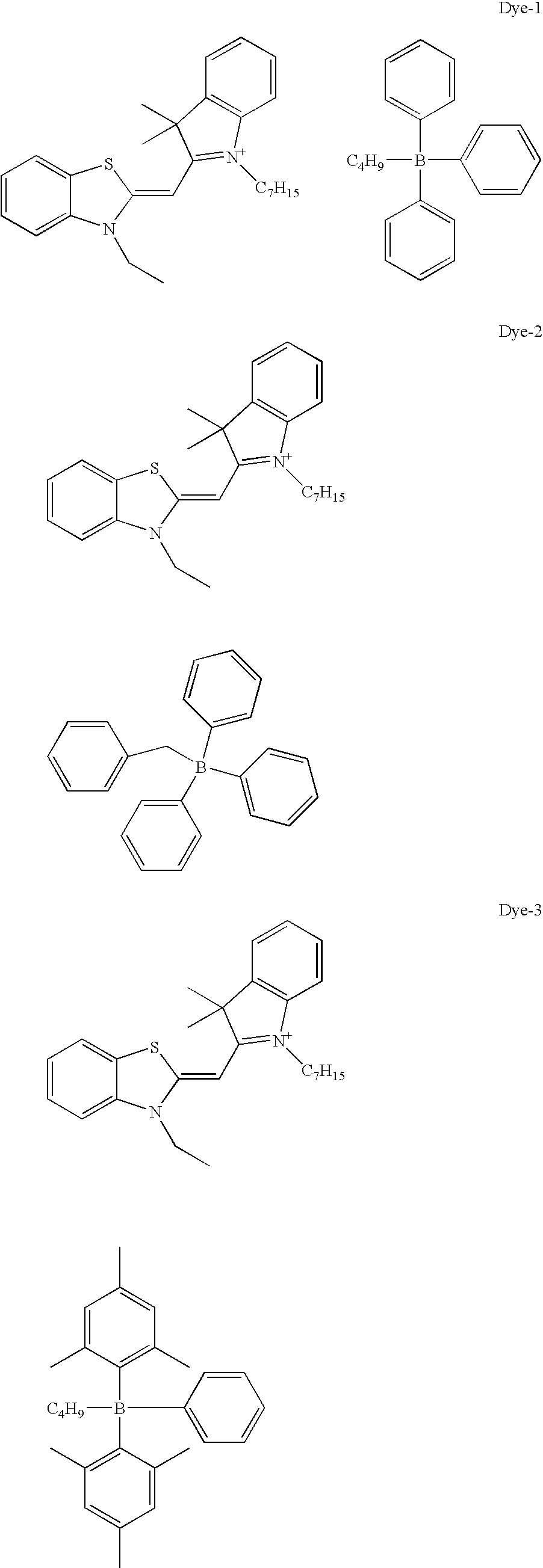Color developer composition and imaging element containing same
a technology of color developer and composition, applied in the field of color developer composition and imaging element containing same, can solve the problems of image degrade image sharpness and resolution, laminated structure adds complexity and cost to manufacture, imaging element yellowing, etc., and achieves improved image quality, good dispersion stability, and excellent color developability.
- Summary
- Abstract
- Description
- Claims
- Application Information
AI Technical Summary
Benefits of technology
Problems solved by technology
Method used
Image
Examples
example 1
Preparation of Developer Zinc Salt of Styrene / Salicylate Resin
Resin 1: Styrene / Methyl Salicylate 4 / 1
[0113] A 22 L, 3-neck flask was fitted with a mechanical stirrer, a nitrogen inlet, and a Claisen adaper. The flask was charged with 3500 ml of dichloroethane, 1522 g of methyl salicylate, and 215 g of concentrated sulfuric acid with stirring at 150 rpm. The reaction mixture was cooled to 0° C., and 4166 g of styrene was added over 240 minutes to control exotherm. The reaction was stirred for 2 hours while the reaction was ramped to 5° C., and 3500 g of distilled water was added over 2 hours. The Claisen adapter was removed and the flask was fitted with a simple distillation head, condenser, and receiver. Dicholoethane was distilled off with some water and the reaction was cooled to 85° C. 1359 g of 50% sodium hydroxide was added slowly over an hiour through the condenser then rinsed with 200 ml of distilled water. The reaction was continued at 85° C. for an additional two hours.
[...
example 2
Samples 1-1 through 1-5
[0117] An organic phase was prepared whereby developer resin 2 was dissolved in ethyl acetate to prepare 399.0 grams of a 50% weight / weight solution in ethyl acetate. 0.9 grams of Aerosol OT (Cytec Industries) was dissolved into the developer / ethyl acetate mixture and the resulting solution was heated to 50° C. An aqueous composition was prepared such that 62.1 grams of a 10% solution of polyvinyl alcohol (Airvol 205, Air Products, Inc.) was dissolved in 537.9 grains of deionized water and the resulting aqueous phase was heated to 50° C. The aqueous phase was added to the organic phase while mixing with a simple propeller mixer. The resulting premix was then subjected to shear using a Silverson Model rotor stator mixer for 5 minutes at a rotor speed of 5500 rpm.
[0118] The resulting aqueous dispersion was transferred to a round bottom flask and the ethyl acetate was removed by rotary evaporation at 68C. under vacuum for minutes. A 100 gram sample of evaporate...
example 3
[0119] An organic phase was prepared whereby developer resin 1 was dissolved in ethyl acetate to prepare 399.0 grams of a 50% weight / weight solution in ethyl acetate. 0.9 grams of Aerosol OT (Cytec Industries) was dissolved into the developer / ethyl acetate mixture and the resulting solution was heated to 50° C. An aqueous composition was prepared such that 62.1 grams of a 10% solution of polyvinyl alcohol (Airvol 205, Air Products, Inc.) was dissolved in 537.9 grams of deionized water and the resulting aqueous phase was heated to 50° C. The aqueous phase was added to the organic phase while mixing with a simple propeller mixer. The resulting premix was then subjected to shear using a Silverson Model rotor stator mixer for minutes at a rotor speed of 5500 rpm.
[0120] The resulting aqueous dispersion was transferred to a round bottom flask and the ethyl acetate was removed by rotary evaporation at 68° C. under vacuum for 45 minutes. The resulting aqueous dispersions were cooled to 25°...
PUM
| Property | Measurement | Unit |
|---|---|---|
| particle size | aaaaa | aaaaa |
| particle size | aaaaa | aaaaa |
| temperature | aaaaa | aaaaa |
Abstract
Description
Claims
Application Information
 Login to View More
Login to View More - R&D
- Intellectual Property
- Life Sciences
- Materials
- Tech Scout
- Unparalleled Data Quality
- Higher Quality Content
- 60% Fewer Hallucinations
Browse by: Latest US Patents, China's latest patents, Technical Efficacy Thesaurus, Application Domain, Technology Topic, Popular Technical Reports.
© 2025 PatSnap. All rights reserved.Legal|Privacy policy|Modern Slavery Act Transparency Statement|Sitemap|About US| Contact US: help@patsnap.com



